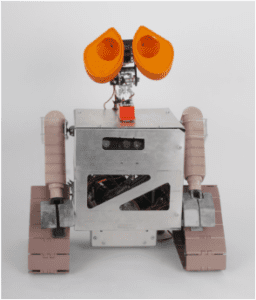I recently had the opportunity to meet Adela Wee, a graduate of Olin College of Engineering, at a local STEM expo where she was demonstrating an autonomous robot she designed and built at college. Her robot, WALL-E, is impressive– it’s a fully integrated mobile robot system that greets you and follows you based on hand gestures.

Adela recently earned a degree in Engineering with a concentration in Robotics from Olin. As someone with a strong affinity for robots and a past president of her high school’s FIRST Robotics team, I knew she’d be able to provide great engineering tips and ideas for high school students who are curious about engineering and want to learn more.
As a high school student, Adela said she was good in math and science but didn’t think about being an engineer until after she joined her high school’s FIRST robotics team. She said, “I really got into building things and figured that I should become an engineer because mechanical engineering was fun, and it seemed logical to pick something I enjoyed doing.”
I asked Adela what advice she would offer high school students who are considering engineering. She said that the world is constantly changing, and if you’re curious about engineering, there is a lot you can explore and learn on your own before heading off to college.
Adela’s following tips will help inspire teens to explore engineering, gather ideas, and develop their skills.
1. Join the Maker Movement and create your own do-it-yourself (DIY) engineering projects at home!
The maker movement is about continuous learning, being creative, and using resources to make something that inspires you. Spend time searching and looking around on project-inspiring websites to get a sense of what’s out there and what’s possible.
Here are Adela’s favorite Maker sites:

a. Instructables: Originated at the MIT Media Lab, this site specializes in user-created and uploaded DIY projects ranging from 3D printing to gardening to robotics and more. The user community comments on and rates projects for quality. You can even enter contests sponsored by well-known companies like Microsoft, K’NEX and HP.
b. Adafruit: Founded by MIT engineer Limor Fried, Adafruit’s goal is to create the best place online for learning electronics and making the best-designed products for makers of all ages and skill levels. Adela especially likes their engineering tutorials hosted on their YouTube channel.
c. Thingiverse: Sponsored by MakerBot Industries, this is the world’s largest 3D printing community widely used by the DIY and the Maker community. Here you can discover, make, and share 3D printable designs and objects.
d. SparkFun: This online retail store sells all the parts you need to make your electronics projects and it includes hundreds of tutorials.
e. Hackster: Billed as the world’s largest hardware creation community, you can learn, share and connect with others to build better hardware.
2. Learn how to build circuits and learn to solder and use a multimeter.
Learning how to use a soldering iron and a multimeter will help when you have to physically build and debug systems. Those skills are always useful to have and will allow you to tinker to your heart’s content.
a. Visit these sites to watch tutorials on how to solder and use a multimeter.
b. Practical Electronics for Inventors and All About Circuits are both great references for electronics.
3. Build your mechanical engineering skills by experimenting with things around your house.
Build pulleys, make levers, try to build bridges out of different materials, or just pick up a drill and a saw and make a box that glows with LEDs.
a. Visit Adela’s go-to-site for designing paper animations at robives.com.
b. She highly recommends these two mechanism books: Mechanisms and Mechanical Devices Sourcebook and Machine Devices and Components Illustrated Sourcebook.
c. To explore how to design on the computer, she recommends a great CAD platform website called Onshape.
4. Read! And, it doesn’t just have to be about engineering!
Find something you’re interested in and go deep by reading books and online sources. Adela has found “that you never know what snippet of knowledge comes in handy, especially as an engineer.” Here are a few of her favorite sources covering a wide variety of topics:
a. Mindset: The New Psychology of Success, by Carol S. Dweck, an expert in motivation and personality psychology. This book focuses on developing your talents and abilities through your own personal mindset. This book encouraged Adela to find positive role models and mentors that were extremely influential in guiding her through decisions in life.
b. The Traditional Bowyer’s Bible by Jim Hamm. Adela loved to make bows and arrows as a kid and recommends this book about archery.
c. Interactive Python is a great online resource to learn the Python programming language. Here you’ll find open-source, interactive textbooks.
d. Webcomic and blog called what if? by Randall Munroe. This comic has a lot of math, science, and tech humor.
e. Janet Echelman and Sayaka Ganz are two of Adela’s favorite artists.
Huge thanks to Adela Wee for her insight! You can check out her projects and learn how she designed and built her autonomous robot, WALL-E, on her website.
Image Source: Wee Projects







